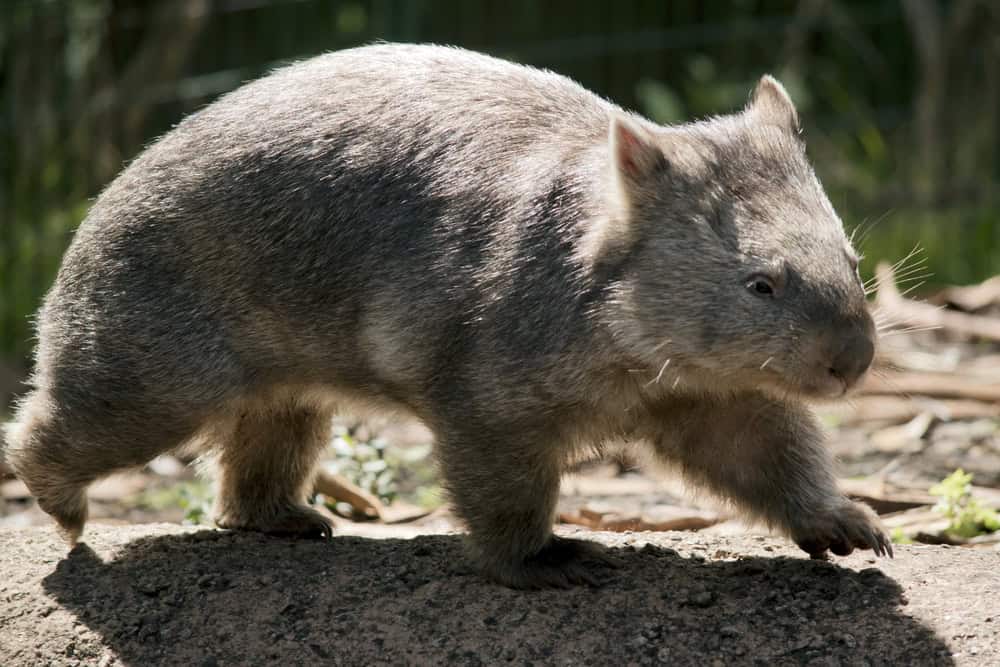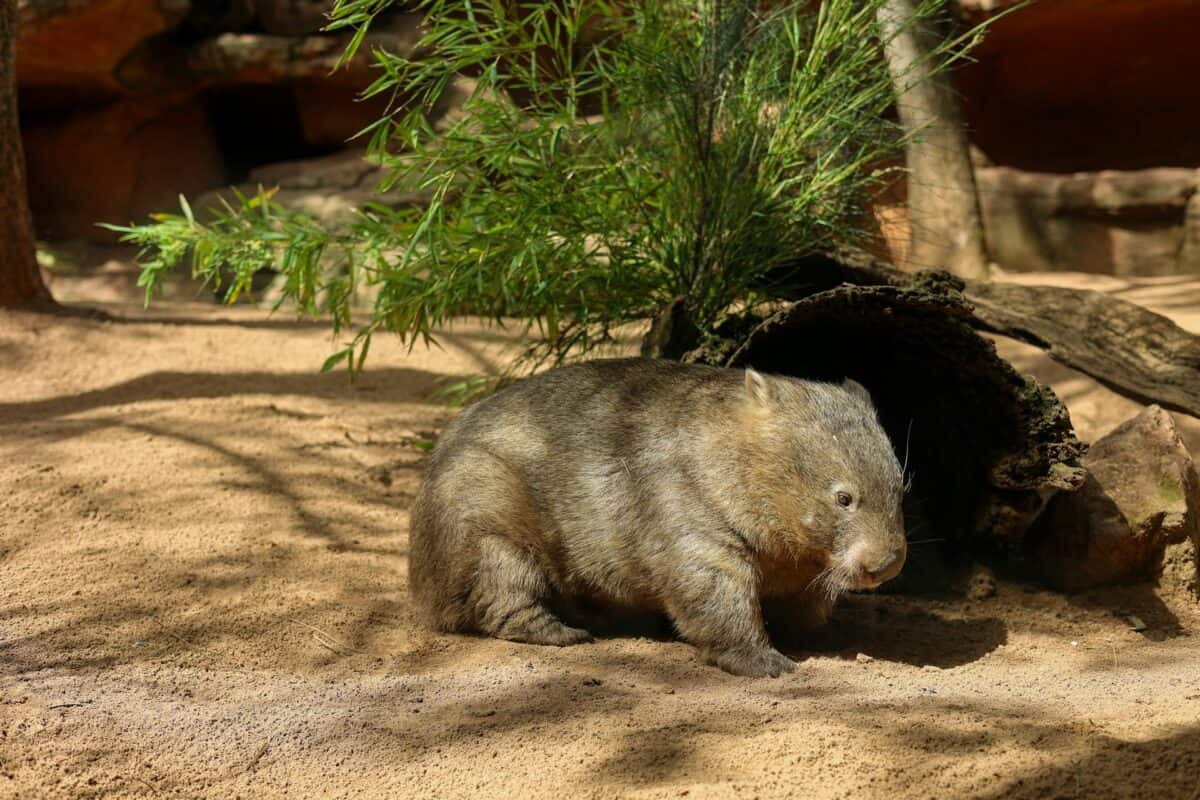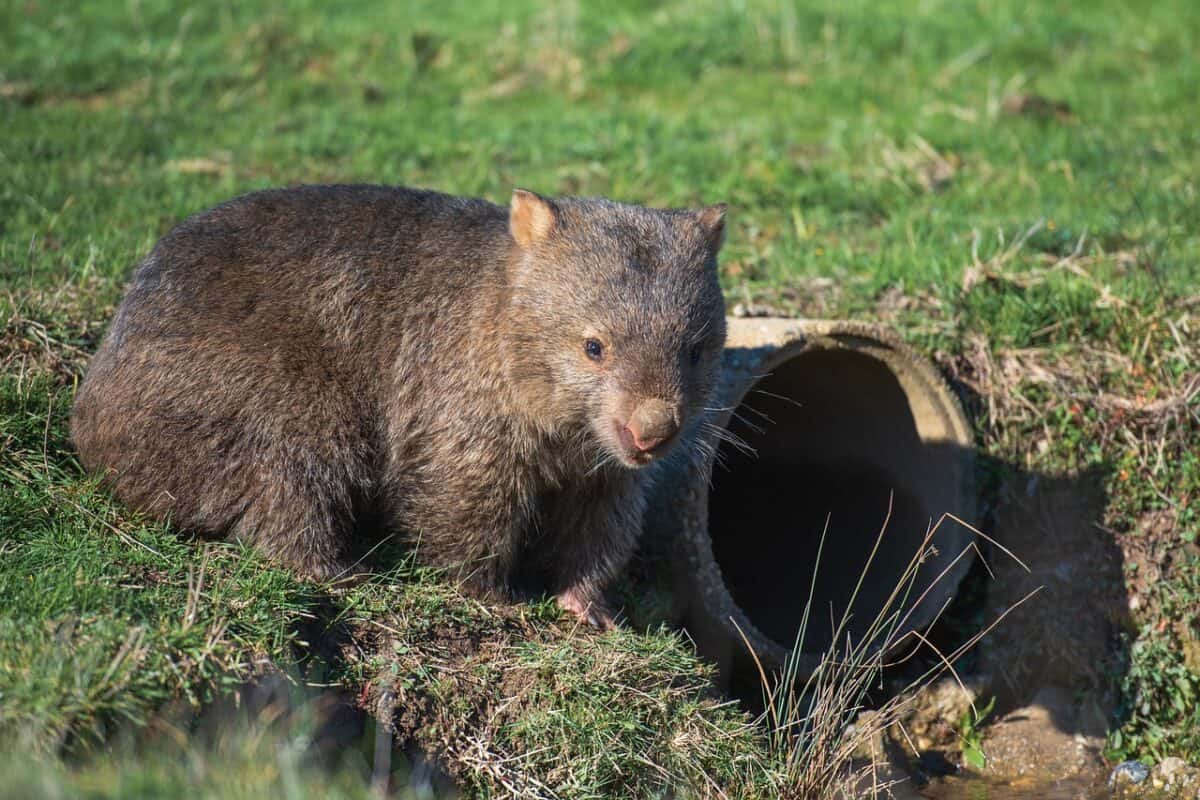Deep beneath the Australian landscape lies a hidden marvel of natural engineering. Wombats, those sturdy marsupials with their barrel-shaped bodies and powerful legs, create underground labyrinths that rival human construction projects in their complexity and design. These remarkable creatures don’t just dig randomly; they craft intricate tunnel systems that demonstrate surprising engineering principles, making them some of nature’s most impressive excavators. Their burrows can span up to 100 feet in length, include multiple chambers, emergency exits, and even incorporate ventilation systems—all created without blueprints, tools, or formal training. Let’s explore how these unassuming animals have mastered the art of subterranean architecture and what we can learn from their innate building expertise.
The Master Architects of the Underground

Wombats are Australia’s premier underground engineers, creating burrow systems that can stretch up to 30 meters (100 feet) in length. These marsupials possess a unique combination of physical attributes that make them exceptionally efficient diggers. With powerful, muscular bodies, short legs, and strong claws, wombats can move approximately 3 cubic meters of soil in a single digging session. Their burrows aren’t simple holes in the ground but carefully constructed networks that include multiple chambers, entrances, and emergency exits. These underground complexes represent decades of excavation work, with some burrow systems being continuously expanded and inhabited for generations of wombats. The precision and functionality of these structures have led researchers to study wombat burrows for insights that might be applied to human engineering challenges.
Physical Adaptations for Digging Excellence

Evolution has equipped wombats with specialized physical features that make them extraordinarily efficient excavators. Their front limbs are particularly powerful, with strong muscles and wide paws tipped with robust claws ideal for breaking through soil and rock. Wombats’ backward-facing pouches—unusual among marsupials—prevent dirt from entering while they dig. Perhaps most impressive is their skull structure, which is remarkably thick and designed to withstand pressure. A specialized plate in their posterior acts as a defensive shield when they retreat into their burrows, effectively blocking predators from entry. Their compact, muscular bodies allow them to apply tremendous force when digging, while their wide, flat foreheads can be used as an additional digging tool to push loose soil out of the way. These adaptations work in concert to create a living excavation machine capable of digging through even hard-packed soils and tree root systems.
The Strategic Layout of Wombat Warrens

Wombat burrows follow surprisingly strategic designs that demonstrate remarkable foresight. A typical warren includes a main tunnel with several side chambers serving specific purposes: sleeping quarters, nurseries for young, and emergency escape routes. These burrows feature multiple entrances, typically 2-4, which provide quick escape options and improved ventilation. Interestingly, wombats design their tunnels with gentle slopes rather than steep inclines, creating efficient drainage systems that prevent flooding during heavy rainfall. The main chambers are often located at the highest points in the warren, offering additional protection from water. Some burrows incorporate narrowing passages that allow the wombat to wedge itself in place, creating a nearly impenetrable barrier against predators like dingoes. This thoughtful architecture reveals that wombat digging behavior goes far beyond instinctive scratching—it demonstrates problem-solving and environmental adaptation that mirrors principles used in human construction.
Burrow Construction Techniques

Wombats employ sophisticated techniques when constructing their underground homes. They begin by excavating a pilot tunnel, gradually widening it as they go deeper. Their digging follows a methodical pattern: they scratch at the soil with their powerful front claws, push it backward beneath their bodies, and then use their hind legs to propel the loose dirt out of the burrow entrance. This systematic approach allows them to create remarkably straight tunnels despite working in complete darkness. When encountering obstacles like tree roots or rocks, wombats will either incorporate these elements into their design or strategically dig around them. During construction, they compact the walls and floors of their tunnels using their hard rumps, creating surprisingly smooth surfaces that reduce collapse risk. This compaction technique is similar to methods used in human construction projects to stabilize soil structures. Even more impressive, wombats have been observed reinforcing their tunnel roofs with roots and other natural materials, demonstrating an intuitive understanding of structural support systems.
Environmental Engineering and Soil Management

Wombats display remarkable soil management skills during their digging operations. They selectively choose digging sites based on soil quality, drainage properties, and stability factors. Researchers have observed that wombats prefer sandy loam soils that strike an optimal balance between being firm enough to maintain structural integrity yet soft enough for efficient digging. During excavation, they effectively sort soil particles, pushing larger pieces to the sides to reinforce tunnel walls while removing finer materials entirely. This selective processing resembles techniques used in human mining operations. The soil displaced during digging isn’t simply discarded; it’s strategically placed at burrow entrances to create raised mounds that serve as lookout points and provide additional drainage benefits. This demonstrates a sophisticated understanding of environmental management that goes beyond simple instinct. Wombats even adjust their digging techniques seasonally, creating deeper burrows during extreme weather periods and performing maintenance excavations to address erosion or structural weaknesses.
Temperature Regulation and Climate Control

One of the most impressive aspects of wombat burrow design is their built-in climate control capabilities. These underground structures maintain remarkably stable temperatures—typically between 15-20°C (59-68°F)—regardless of external conditions, which can range from below freezing to over 40°C (104°F) in the Australian outback. This temperature regulation is achieved through strategic design features. The depth of the burrows (usually 1-3 meters below surface) utilizes the earth’s natural insulating properties. Multiple entrances create cross-ventilation flows that help manage humidity and air quality. The curved, spiral pattern of many wombat tunnels serves to block wind and control airflow. In hot conditions, wombats dig deeper to access cooler soil layers, while in colder weather, they may block certain entrances to retain heat. Some researchers have noted that wombat burrows demonstrate principles similar to those used in passive building design, where structural elements are arranged to naturally regulate temperature without mechanical systems. This sophisticated environmental engineering allows wombats to thrive in harsh climates where surface temperatures would otherwise be lethal.
Social Architecture: Sharing and Territorial Design

While wombats are generally solitary animals, their burrow architecture reflects complex social considerations. Each wombat typically maintains a primary burrow for itself, but these structures often connect to larger networks shared by multiple individuals. This arrangement creates a fascinating balance between privacy and community. Burrows frequently feature “neutral zones” or shared tunnels that multiple wombats may use without territorial conflict. However, personal sleeping chambers remain strictly private. When a wombat leaves its burrow, others may temporarily occupy it, but the original occupant reclaims it upon return—a system facilitated by scent marking. More fascinating still, wombat warrens sometimes feature “guest chambers” near the periphery that transient wombats may use, similar to visitor accommodations in human dwellings. This sophisticated social architecture demonstrates that wombat engineering extends beyond physical construction to incorporate complex social dynamics. During breeding seasons, females modify their burrows to create nursery chambers with enhanced safety features and temperature stability for raising young.
Scientific Study of Wombat Engineering

The engineering prowess of wombats has attracted significant scientific interest. Researchers have used ground-penetrating radar and specialized cameras to map these underground structures without disturbing their inhabitants. These studies reveal that wombat burrows frequently incorporate principles similar to those taught in human engineering schools. The angle of tunnel descent typically maintains a consistent 5-15 degree slope—optimal for both drainage and traversability. Wall thickness varies precisely according to soil composition and overhead weight. In 2020, a research team from the University of Tasmania discovered that burrow dimensions maintain a remarkably consistent ratio to the wombat’s body size, with tunnels typically 1.3 times the width of the animal. This precision ensures the wombat can turn around anywhere in its burrow while maintaining a tight enough fit to wedge against predators. Computer simulations comparing wombat burrows to human-designed tunnels have shown that wombat constructions often achieve comparable structural stability ratings despite being created without mathematical calculations or modern materials. This growing body of research suggests that studying wombat engineering techniques may provide valuable insights for human underground construction projects.
Ecological Impact of Wombat Engineering

Wombat burrows represent a form of ecosystem engineering that significantly impacts their environments. Each burrow system can move tons of subsoil to the surface, effectively aerating and mixing soil layers in a process ecologists call bioturbation. This mixing enhances soil fertility by redistributing nutrients and organic matter. The burrows themselves create microhabitats utilized by numerous other species—over 70 different animals have been documented using active or abandoned wombat burrows, including reptiles, small mammals, and invertebrates. During wildfires, these underground structures serve as critical refuge sites where multiple species can shelter from the flames. The entrance mounds create varied topography that captures water and seeds, promoting vegetation diversity. Wombat digging also accelerates the breakdown of organic matter and improves water infiltration into soil. Some agricultural researchers have noted that areas with wombat activity show improved soil structure and water retention compared to similar landscapes without wombat presence. This ecological engineering demonstrates how a single species’ construction activities can enhance biodiversity and ecosystem resilience through their sophisticated tunneling behavior.
Comparing Species: Engineering Differences

Australia’s three wombat species—the common wombat (Vombatus ursinus), the southern hairy-nosed wombat (Lasiorhinus latifrons), and the critically endangered northern hairy-nosed wombat (Lasiorhinus krefftii)—each display distinctive engineering approaches. Common wombats, found in wetter, more temperate regions, typically create simpler burrow systems with fewer entrances but longer main tunnels that can extend up to 20 meters. Their burrows often follow ridge lines and feature sleeping chambers lined with dry vegetation. In contrast, the hairy-nosed species, adapted to arid environments, construct more complex, branching networks with numerous entrances and interconnected chambers. The southern hairy-nosed wombat’s burrows can house multiple individuals and include specialized chambers with different functions. The northern hairy-nosed wombat, despite its rarity, creates the most elaborate warrens of all, with some systems spanning over 100 meters and incorporating up to 12 entrances and multiple levels. These differences reflect evolutionary adaptations to local conditions: complex burrows in arid regions provide better temperature regulation and water conservation, while simpler systems in temperate areas prioritize drainage and flood prevention.
Human Applications of Wombat Engineering
The sophisticated tunneling techniques of wombats have inspired various applications in human engineering. Mining engineers have studied wombat digging methods to develop more efficient and safer excavation techniques for underground operations. The wombat’s ability to create stable tunnels through varying soil types without sophisticated tools has influenced the development of new boring machines that mimic their digging patterns. Urban planners examining underground construction challenges have looked to wombat burrow ventilation systems when designing subsurface structures like subway systems and utility tunnels. The natural temperature regulation within wombat burrows has influenced passive cooling designs in sustainable architecture. Military engineers have studied the defensive aspects of wombat burrows to improve bunker designs. Perhaps most significantly, conservation biologists have applied knowledge of wombat burrow construction to create artificial habitat structures for endangered species, replicating the microclimate and protection features of natural burrows. As climate change intensifies, some futurists even suggest that wombat burrow principles could inform designs for human underground dwellings in regions becoming too hot for surface habitation.
Conservation Challenges for Nature’s Engineers

Despite their engineering brilliance, wombats face significant conservation challenges that threaten their survival and ecological contributions. Habitat loss represents the primary threat, with agricultural expansion, urban development, and mining activities destroying the suitable burrowing areas these specialized diggers require. Road construction frequently cuts through their territories, resulting in high vehicular mortality. The northern hairy-nosed wombat is now critically endangered, with fewer than 250 individuals remaining in the wild. Introduced predators like foxes and feral dogs target young wombats, while competition with introduced rabbits for grazing resources adds additional pressure. Climate change poses particular threats to these underground engineers, as increasing drought frequency and intensity in many Australian regions makes soil harder to excavate and reduces the vegetation wombats depend on for food. Sarcoptic mange, a debilitating parasitic disease, has devastated some wombat populations, causing painful death and reduced reproduction rates. Conservation efforts focus on habitat protection, disease management, and in some cases, translocation programs to establish new populations. Protecting these natural engineers is essential not just for their intrinsic value but for maintaining the ecosystem services their tunneling activities provide.
Conclusion: Lessons from Underground Architects

Wombats stand as remarkable examples of nature’s engineering capacity, demonstrating how evolutionary processes can produce sophisticated construction techniques without formal training or tools. Their burrow systems, with carefully designed drainage, ventilation, security features, and temperature regulation, showcase problem-solving abilities that rival human engineering principles. As climate change and environmental challenges increase worldwide, the wombat’s adaptive engineering may offer valuable insights for sustainable human construction. The ecological benefits of their burrows extend far beyond their own needs, creating refuge habitats that support dozens of other species and improve soil health across vast landscapes. By studying and protecting these unassuming yet brilliant engineers, we not only preserve a unique species but also maintain access to a living laboratory of underground architectural principles refined over millions of years of evolution.
- Bald Eagles Were Almost Gone From Alaska, But Now They’re Thriving Again - August 18, 2025
- Urban Growth Is Draining U.S. Waterways - August 18, 2025
- Wombats Dig Tunnels Like Engineers - August 18, 2025

